- Baby Pottying

Baby-led pottying / ec holds and positions
- More links:
- Benefits
- Clothing
- Holds
- When?
- Out and About
- Entertain
- Catching
- Missing
- Pre-empt
- Quick-Start Nights
- Nappy-free Nights
- Your Experiences
- Constipation
Baby Pottying Positions (blpt / ec holds)
All of these positions keep the baby's body relatively upright and their knees apart. With the in-arms holds you can open their legs and raise their knees above their hips to put a little bit of pressure in all the right places while relaxing the pelvic floor muscles.
Classic / traditional / in-arms hold, Supported on a potty, Sitting on a potty, Supported on a toilet, In your lap on a toilet.
Skip to the end to see some additional tips for boys.
Classic / Traditional / In-Arms Hold
Support the baby's back against your torso and put your hands under their thighs so that they are in a suspended squat position. (Take aim - in this position girls will produce a horizontal jet of wee that covers quite a distance.)
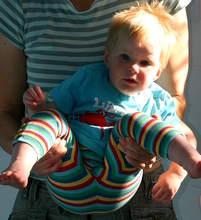

Sixteen months - demo of traditional 'in-arms' hold.
Newborns: Small light babies can be supported entirely using your fingers, wrists and one forearm. Heavier children need a full hand under each thigh and can rest against your chest or stomach.


Three weeks - 'in-arms' hold over top hat potty bowl. Fingers support her thighs, wrists and forearm support her body and head.
At six weeks we're using a similar position, but forearm support is no longer needed.
Wiping up: Once the baby has a little bit of upper body strength it is easy to support them against your torso and hold one leg while you reach for loo roll with the other hand.
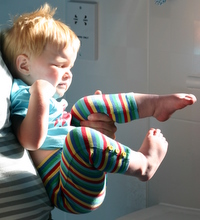
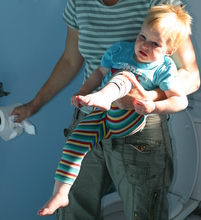
Also very secure with just one hand when the other is reaching for something.
Outside: I like to get fairly low to the ground and support my elbows on my knees. I clamp my forearms under her arms to support her upper body.
My Experience: A very useful and versatile position - we used it from birth with my second daughter.
With my first daughter we didn't start pottying her until she was 6 months old and by then she didn't want to be held in this position at all! Initially she would only stand, but after a while she got used to the potty. We couldn't use this position until she was nearly two.
Supported on a Potty
This one can be good for a cuddle, or if your child is heavy, or if you want everything to be nicely contained in a suitable receptacle.
Simply sit the child on the potty and give them as much support as they need.
(If you're dithering over a potty purchase, go with small and cheap - and read my article on how to choose the best potty for ec-ing a baby or young toddler.
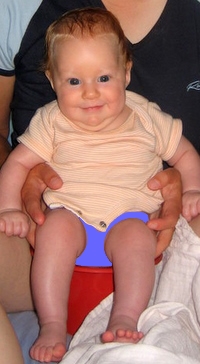

Eleven weeks - same traditional hold. Fingers support her thighs, wrists support her bottom, and here her back is resting against my chest.
Four months - supported sit on the potty. Here she's wearing split crotch trousers - they open to reveal her bottom when she's in this position. (Have you seen SplitSuits, my zippered split crotch onsies? They're fabulous, though I do say so myself!)
Sitting on a Potty
I think it's common for babies to be able to balance on the potty before they are able to sit on the floor. Once they can sit without assistance they can play with or watch you and generally amuse themselves - and it gives you a couple of minutes to mop up after dinner. Who needs a bumbo?


Four and a half months - just learning to balance on a potty.
Eight months - happily playing while Mum cleans up after dinner.
Supported on a Toilet
There are three ways to support your baby on the toilet:
- Standing or squatting with feet either side of the hole
- Sitting as you would sit, but with their bottom lowered a little way into the toilet bowl
- Supported in the in-arms hold facing the cistern with their bottom resting on the toilet seat.
You can also use a toilet seat reducer (also known as an insert or infant seat) to make the hole a more manageable size.
Sitting on Your Lap on the Toilet
I've never managed this myself, but other people seem to!
- Sit as normal with your baby on your lap facing you
- Sit facing the cistern with your baby on your lap facing you.
- Sit facing the cistern with your baby on your lap also facing the cistern - only their feet touch the seat and you have clothes on so no need to worry about public toilet seats.
Additional Tips for Boys
Parents of boys often think that pottying (and especially nappy free time) will be more difficult for them.
I only have girls, so I'm really not qualified to comment. However, plenty of infant pottiers do have boys, so I've asked around for specific advice.
"My boys have never stayed still enough to do anything on the potty except strictly business - and for both of them from 12/14 months onwards I have to hold them on the toilet or in a traditional hold outside/over the potty for any chance of getting something in there!"
"At night, I hold him over the bath so I don't have to aim in the dark!"
Other people recommend a traditional hold but use an index finger to 'point him in the right direction'.


Four and a half months - Dad is aiming by capturing everything! He has his son's penis and testicles between his fingers. Mum usually manages with just one finger directing the hose, but she's taking the photo...
Eight months - throne potty. His feet don't touch the floor so he can't escape!
Nappy Free Time for Boys
Nappy free doesn't have to mean naked. It often does - and it needs to if your lad is going to see what is happening and learn about his body.
But don't let fear of a huge arc of wee prevent you from giving this a go.
Stem the flow with something light and comfortable to wear. Fasten the poppers on his vest but leave the nappy off. Put him in a long t-shirt. Give him cotton pants (if you can find a pair small enough). Drape a muslin over him. Tie a bib around his waist. Get inventive so that you can get started.
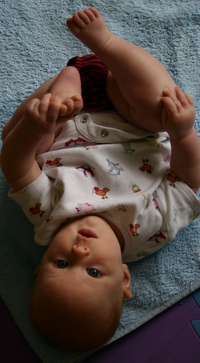
Four months - nappy free time with pants on.

Sixteen months - traditional hold. When outside I like to position her low to the ground and support my elbows on my knees. My forearms clamp under her arms to support her body.

Five months - sitting on the potty without support. From here on it's plain sailing!
No Signals? Try Sign Language!
Get Started The Easy Way!
Create your own personal cheat sheet.
I'll guide you through your options as if you were at one of my workshops.
(It's free...)
Helpful Links
Benefits of baby-led pottying / ec
Best clothing for pottying / ec
Pottying / ec holds and positions
When to offer the potty (make your own luck)
How to entertain your baby on the potty
Evening pre-emptive wee / lift / dream pee
Quick start guide to night time pottying / ec
Why night nappies and night pottying / ec are a great combination
Your experiences: Why other parents started pottying and how they got on.
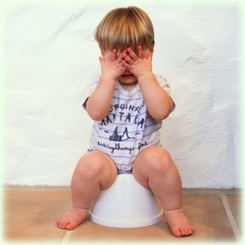
Potty Training for Toddlers: Understand how your toddler learns.

